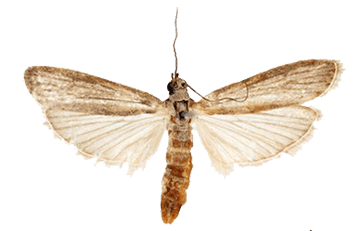Mediterranean flour moths
SIZE: Mediterranean flour moths can grow up to five-eighths of an inch in length with a wingspan less than one inch.
DESCRIPTION: These moths have a brownish black body with the front part of their wings a pale gray and the back a cream color. They also have patterns that look like black waves.
BEHAVIOR: Female Mediterranean flour moths lay their eggs in suitable areas which can be in food material. The new born larva spins silken tubes and spends most of its life there feeding, this silk causes balls to form which can cause issues for machineries in flour mills by causing clogs which can take a lot of time to clean out. The larvae will mainly pupate in food substances like flour or within a pile of flour but sometime they will pupate in cracks and crevices as well. These moths can be spotted due to their flying pattern which can be in a rapid zigzag fashion. The life cycle of a Mediterranean flour moth can be 4 to 6 weeks depending on temperature, they strive in much warmer climates with 6 or more generations occurring within a year.

HABITATS: Mediterranean flour moths can a big nuisance due to them inhabiting food supply areas. These moths can be a serious problem in flour mills or warehouses, they can even be found in grocery stores, supermarkets, homes, restaurants, drugs store, convenience stores and even in combs of honeybee nests. These insects not only feed on flour but also like foods such as dried fruits, biscuits, beans, chocolates, seeds, and nuts.
TIPS FOR CONTROL
- Discard of all infested foods in an outdoor trash can. Also all infested house decorations such as flowers, wreaths etc. should also be discarded.
- Freeze all suspected food for about 6 days.
- Clean all cabinets, cupboards and shelves where an infestation occurred. Clean with soap, water and vacuum.
- Storage of all flour, dried food, pet food etc. should be within a glass or plastic air tight container so that if there is an infestation within those items it will not spread.
- Consume older foods before purchasing new items to keep your food storage to a minimum. Products purchased in high quantity have more chances of being infested due to them being around for longer periods of time especially if not stored correctly in air tight containers.